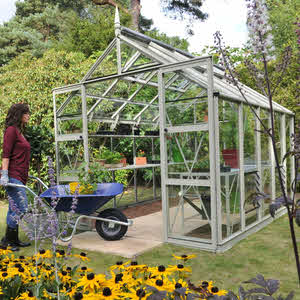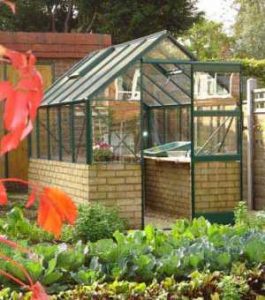When you realise that a greenhouse will make a huge difference in what you grow and how you grow it, the first thing you need to consider is what sort of greenhouse you want. This article gives some good advice and pointers to buying a greenhouse.

Top of the range, Harrod Superior Greenhouse
Comes with a 25 year framework guarantee, 4mm toughened glass and packed full of features. Including integral roof blinds along one side of the roof and vast amounts of ventilation to provide the best possible growing environment.
Greenhouses are available in all shapes and sizes, and take forms that vary from the conservatory to an enclosed glass porch around the front door. All are very useful for the hobby gardener and can accommodate a surprisingly large number of plants of all kinds.
Main Types of Greenhouse
Modern greenhouses basically come in four forms; the lean-to, in which one wall is formed by the home or other substantial building; the span roof type, which is built on a dwarf wall and has a pitched roof; the Dutch light kind, formerly constructed of Dutch lights but in the modern form a glass-to-ground greenhouse, and the hexagonal type that is, broadly speaking, dome-shaped but with angular sides. All have their adherents, but it is generally conceded that the span roof type of greenhouse proves to be the most versatile when a wide range of plants are to be grown.
Glass or Plastic Greenhouse
Greenhouses can be constructed from many different materials. Polyethylene structures are cheap to purchase initially, but need re-covering every two years and in winter will often suffer wind or snow damage. Those made from corrugated acrylic sheet are little better, cracking and discoloring with the weather, although polycarbonate materials are more durable and can be recommended.
Glass is obviously the most satisfactory option, but the best material for the framework is more difficult to decide.
Editorial Note: For safety with children and for strength, consider toughened glass glazing.

Greenhouse with Dwarf Wall from TwoWest & Elliott’s range of greenhouses.
Dwarf wall houses can look very attractive but it does mean there is no border space available for direct growing.
Wood or Aluminium Greenhouse?
Cedar and teak that are kept well oiled are obviously ideal, but very expensive, while ordinary softwood painted white looks good but has a very limited life.
Aluminium would seem to be the best answer as it does not rust, but with some greenhouses the bolts and screws holding the structure together are made from steel and are liable to corrode. So inspect any intended purchase of this kind very carefully, and select an all aluminium model.
Greenhouse Staging
Ideally staging should be provided at waist height down either side of the greenhouse and a shelf near the ridge is very useful if this can be kept above head height.
Ventilation must be adequate and most gardeners agree that both side and ridge ventilators are essential for proper airing during the summer months. A good wide door is necessary for easy management. It should be wide enough to take a wheel-barrow without skinning your fingers and with no troublesome step or ramp. Also see: Greenhouse Staging
Greenhouse Heating
Heating is desirable, but may be prohibitively expensive. If you do decide to heat your greenhouse then purchase an electrical fan heater. Not only does this provide warmth, but it also circulates the air on damp days in the fall. In the summer the fan can be switched to the cool air position to reduce the high temperatures and provide air circulation. Propane gas and kerosene heaters, although very reliable, are not so desirable as they produce a damp heat, and by virtue of their mode of operation do not readily circulate the air. Also see: Greenhouse Heating
Greenhouse Insulation
If you are able to afford to heat your greenhouse, it also makes sense to insulate it to minimize heat loss. There are many methods of doing this, but the clear plastic bubble insulation material now available is simple to fix and rarely causes any problems with condensation. Clear polyethylene has always been considered to be the most suitable insulation, causing minimal reduction in light and trapping a barrier of air. However, it has always been associated with condensation, a build up of light-reducing algae, and a fragility which is not so evident in modern clear bubble insulation. Also see: Greenhouse Insulation
Whatever insulation you choose, it is important when fastening it to the internal structure of the greenhouse that provision is made for the opening of ventilators. Insulation may well still be useful at night during spring, but on sunny days the temperature will soar and full ventilation may be necessary.
Correct siting of the greenhouse is vital if plants are to develop properly. Choose an open part of the garden in full sun. It is a simple matter to shade a modern small greenhouse if the sun becomes too bright. The uncontrollable shade of a tree or building on the other hand can lead to very poor and disappointing plant growth.
About the author: Philip Swindells has over 40 years gardening experience. A former botanical garden curator and an international horticultural consultant, he has worked extensively in the UK, North America, the Middle East and Australia. The Author of more than 50 gardening books, he has been awarded a Quill and Trowel Award by the Garden Writers’ Association of America. He is also a former UK Garden Writer of the Year.
Greenhouse Growing, Coldframes etc. Further information
- Best Position for a Greenhouse – Where to Site a Greenhouse
- Greenhouse Capillary Matting: A Comprehensive Overview
- Understanding Greenhouse Planning Permission: What You Need to Know
- Wooden Greenhouses Compared to Aluminium
- Greenhouse Heating Guide – Various Types Reviewed
- Second Hand Greenhouse – Buying, Dismantling and Re-building a Greenhouse
- Greenhouses in High Winds – Protect and Survive!
- Greenhouse Accessories for Heating and Ventilation
- Fitting out the Greenhouse: Shelving, Staging & Greenhouse Benches
- Watering the Greenhouse – Equipment to Help Greenhouse Watering
- Portable Greenhouses – Patio Greenhouses and Allotment Greenhouses
- Managing the Hobby Greenhouse
- Cold Frames – Uses of Coldframes – Types of Coldframe
- How to Build a Cold Frame for Free!
- An Indoor Greenhouse – The Dewpoint Propagating & Growing Cabinet
- Choosing a Greenhouse – What Greenhouse to Buy



